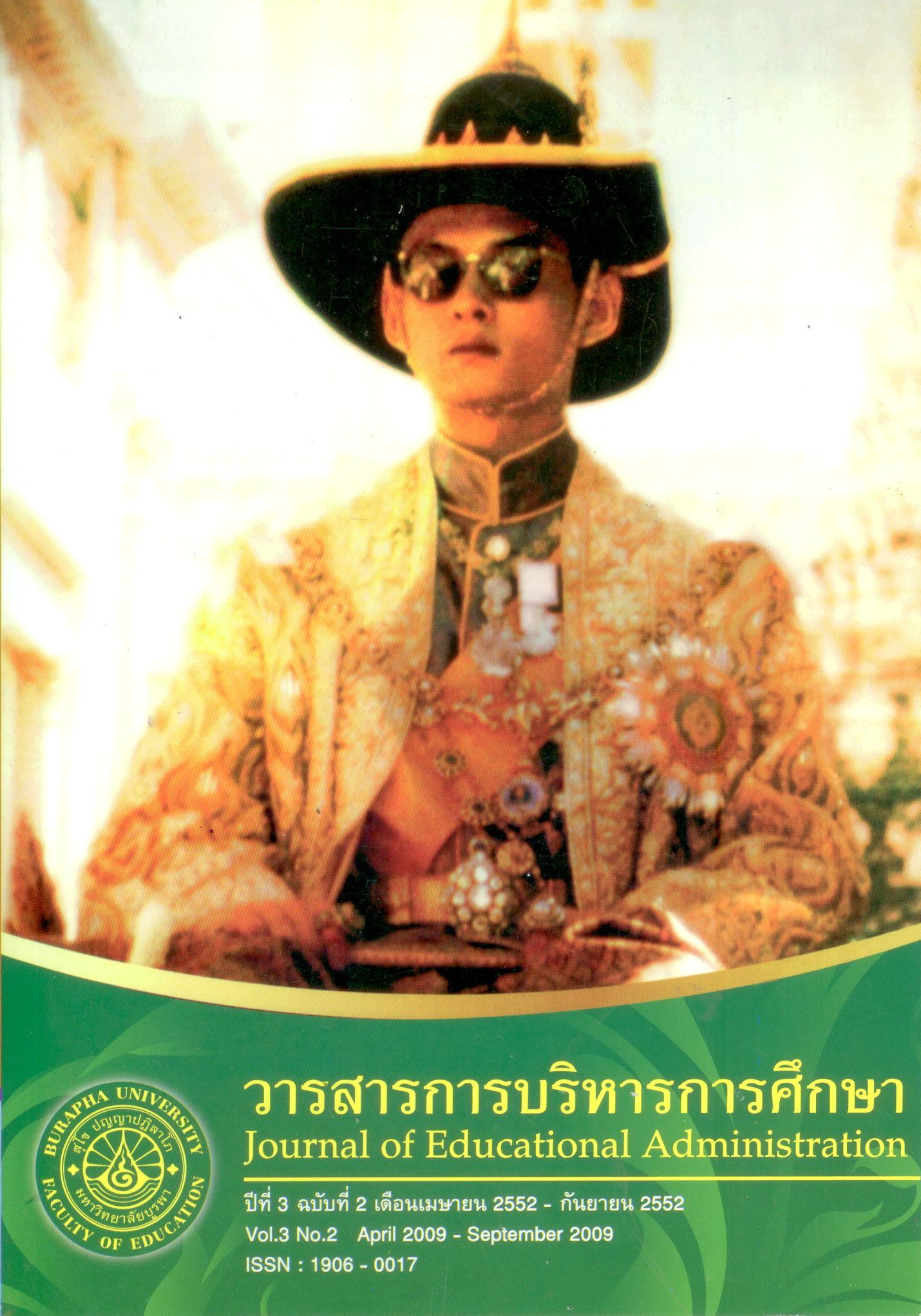การวิเคราะห์เปรียบเทียบรูปแบบการบริหารโรงเรียนชั้นนำขนาดเล็ก ในชนบทที่มีประสิทธิภาพ : กรณีศึกษาโรงเรียนบ้านหนองหญ้าปล้อง สำนักงานเขตพื้นที่การศึกษาบุรีรัมย์ เขต 1 และโรงเรียนบ้านแม่จ้อง สำนักงานเขตพื้นที่การศึกษาเชียงใหม่เขต 1 A Comparative Analysis of...
Abstract
บทคัดย่อ
การวิจัยนี้มีวัตถุประสงค์เพื่อ 1) วิเคราะห์รูปแบบการบริหารจัดการที่มีประสิทธิภาพภูมิหลังเงื่อนไขที่ส่งเสริมและอุปสรรคต่อการบริหารและ 3) เปรียบเทียบความเหมือนและความแตกต่างกันของการบริหารจัดการโรงเรียนชั้นนำขนาดเล็กในชนบทที่มีประสิทธิภาพในภาคเหนือและภาคตะวันออกเฉียงเหนือ จำนวน 2 โรงเรียน โดยใช้เทคนิคการวิจัยเชิงคุณภาพ (Qualitative Research) ได้แก่ โรงเรียนบ้านหนองหญ้าปล้อง สำนักงานเขตพื้นที่การศึกษาบุรีรัมย์เขต 1 และโรงเรียนบ้านแม่จ้อง สำนักงานเขตพื้นที่การศึกษา เชียงใหม่ เขต 1 โดยเลือกกลุ่มตัวอย่างแบบเจาะจง ได้แก่ ผู้อำนวยการโรงเรียน ครู นักเรียน คณะกรรมการสถานศึกษาขั้นพื้นฐาน ผู้นำชุมชน ผู้นำองค์กรปกครองส่วนท้องถิ่น ผู้ปกครอง และภูมิปัญญาท้องถิ่น เก็บข้อมูลโดยใช้วิธีการศึกษาเอกสารการสัมภาษณ์ระดับลึก (In-depth Interview) การสนทนากลุ่ม (Focus group discussion) และการสังเกตและจดบันทึก (Observasion and Field-Note) วิเคราะห์ข้อมูลแบบสร้างข้อสรุปโดยวิเคราะห์เนื้อหาเกี่ยวกับรูปแบบการบริหารจัดการของแต่ละโรงเรียน (Illustrative Model) วิเคราะห์เชิงวัฒนธรรม (Cultural Analysis) วิเคราะห์ภาพความสำเร็จ (Successive approximation) และตรวจสอบข้อมูลโดยใช้วิธีการตรวจสอบแบบสามเส้าด้านวิธีรวบรวมข้อมูล (Methodological Triangulation) และตรวจสอบแบบสามเส้าด้านผู้วิจัย (Investigator Triangulation) แล้วนำหลับไปให้ผู้ให้ข้อมูลอ่านซ้ำอีก (Reflecting)
ผลการวิจัยพบว่า
โรงเรียนบ้านแม่จ้องกำหนดโครงสร้างการบริหารงานเป็น 5 งาน และกำหนดรูปแบบการบริหารงานที่เรียกว่า “แม่จ้องบวร” คือ บ้าน วัด และโรงเรียนร่วมกันบริหารและจัดการศึกษาส่วนโรงเรียนบ้านหนองหญ้าปล้อง กำหนดโครงสร้างการบริหารเป็น 4 งาน และบริหารจัดการศึกษาโดยเน้นการบูรณาการของการมีส่วนร่วมจากฝ่ายต่างๆ อย่างเหมาะสมกับบริบทของโรงเรียนและชุมชน สำหรับเงื่อนไขที่ส่งเสริมการบริหารที่มีประสิทธิภาพของทั้งสองโรงเรียน ได้แก่ ผู้อำนวยการ เป็นผู้บริหารมืออาชีพ ครูมีความรับผิดชอบต่อหน้าที่ มีความสามัคคีและร่วมกันพัฒนาคุณภาพการศึกษาอย่างต่อเนื่อง คณะกรรมการสถานศึกษาขั้นพื้นฐาน เป็นฝ่ายนำในการพัฒนาและแก้ไขปัญหาต่างๆ ของโรงเรียน ผู้นำทางศาสนามีบทบาทที่สำคัญ ในการดำเนินกิจกรรมพัฒนาในชุมชน และการเรียนการสอน ผู้นำองค์กรปกครองส่วนท้องถิ่น และผู้นำชุมชน ให้การสนับสนุนอย่างจริงจัง ส่วนเงื่อนไขที่เป็นอุปสรรคต่อการบริหารของทั้งสองโรงเรียนได้แก่ระบบราชการทำให้การปฏิบัติงานล่าช้า ได้รับงบประมาณไม่เพียงพอ รายได้ประชากรอยู่ในเกณฑ์ต่ำ และสถาบันครอบครัวของคนในชุมชนอ่อนแอ สำหรับผลการวิเคราะห์เปรียบเทียบโรงเรียนชั้นนำขนาดเล็กที่มีประสิทธิภาพทั้งสองโรงเรียน พบว่า มีลักษณะร่วมที่เหมือนกันคือผู้อำนวยการเป็นผู้บริหาร มืออาชีพ คณะครูทำงานเป็นทีมมีความสามัคคีช่วยเหลือซึ่งกันและกัน คณะกรรมการสถานศึกษาและผู้นำชุมชนให้การสนับสนุนจัดให้นักเรียนได้สืบทอดภูมิปัญญาท้องถิ่น และมีการกระจายอำนาจการบริหาร ส่วนที่ต่างกันคือ การจัดโครงสร้างการบริหารงาน และผู้อำนวยการโรงเรียน ทั้งสองแห่งมีกลยุทธ์ในการบริหารที่แตกต่างกันผู้อำนวยการโรงเรียนบ้านหนองหญ้าปล้อง เน้นที่การปฏิบัติตนเป็นแบบอย่างที่ดีโดยเฉพาะเรื่องการจัดการเรียนการสอนส่วนผู้อำนวยการโรงเรียนบ้านแม่จ้องเน้นทีมงานและการมีส่วนร่วมของผู้มีส่วนได้ส่วนเสีย (Stakeholder)
ABSTRACT
The objectives of this study were threefold: (1) to analyze the effective administration model and background of small-sized leading schools in remote areas of the northern and northeastern Thailand, (2) to examine promoting conditions and obstacles in school administration, and (3) to compare the similarity and contrast the difference in school administration of two schools namely Ban Nongyaplong school, under the jurisdiction of the Office of Burirum Educational Service Area I and Ban Maejong school under the jurisdiction of the Office of Chiang Mai Educational Service Area 1. The investigation employed the qualitative research method and the purposive sampling technique in the selection of the samples of the study. The samples included school directors, teachers, students, school committee, community leaders, local government officials, parents, and local wisdom. The research instrument consisted of documentary studies, in-depth interview, focus group discussion, observation, and field-note. Content analysis of illustrative administration model, cultural analysis, and successive approximation were employed in the analysis of collected data. The data collected were assessed by using methodological triangulation, investigator triangulation, and key informant’s reflecting triangulation.
The research findings were as follows:
Ban Maejong school has divided administrative model into five departments and established the model for its administration known as “Maejong Bor-Won” referring to Home or Community, Buddhist Temple, and School Model. The three components have been encouraged to support educational provision to students in its service area. Ban Nongyaplong school, however, has divided its administration into four departments and focused on the integration of cooperation from the involved bodies appropriate to the school and community context.
In terms of conditions promoting the effectiveness of school administration of the two schools, it was found that factors, that is, the professionalism of school directors, responsible teachers, the unity and cooperation of staff in continuously developing the quality of education played an important role in the school effective administration. In addition, the school committee was found to be the leader in developing and solving all problems happening in schools. The religious leaders were also found to be a key factor in developing the community and schools in relation to teaching and learning aspect, and the local government officials and the community leaders were found to be the key supporter of the school administration.
The bureaucracy causing the delay in work operation, insufficiency of budget, low income of the people in community, and the weakness of families in the community were found to be the conditions disrupting the effectiveness of school administration of the two schools.
For the comparison and contrast of the two schools, the professionalism of school directors, team working of the teachers, the support from the school committee and local leaders in providing students with local knowledge and skill conservation, and decentralized administration were found to be the similarities of the administration of two small-sized schools. The differences between two schools included the administration model and the administrative strategies used by the school directors. Regarding the administrative strategies, the director of Ban Nongyaplong school focused on living and working himself as a good example particularly in teaching and learning whereas the director of Ban Maejong school concentrated on team working and the cooperation of school stakeholders.


